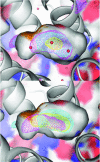Cooperative water filling of a nonpolar protein cavity observed by high-pressure crystallography and simulation
- PMID: 16269539
- PMCID: PMC1283839
- DOI: 10.1073/pnas.0508224102
Cooperative water filling of a nonpolar protein cavity observed by high-pressure crystallography and simulation
Erratum in
- Proc Natl Acad Sci U S A. 2006 Mar 21;103(12):4793
Abstract
Formation of a water-expelling nonpolar core is the paradigm of protein folding and stability. Although experiment largely confirms this picture, water buried in "hydrophobic" cavities is required for the function of some proteins. Hydration of the protein core has also been suggested as the mechanism of pressure-induced unfolding. We therefore are led to ask whether even the most nonpolar protein core is truly hydrophobic (i.e., water-repelling). To answer this question we probed the hydration of an approximately 160-A(3), highly hydrophobic cavity created by mutation in T4 lysozyme by using high-pressure crystallography and molecular dynamics simulation. We show that application of modest pressure causes approximately four water molecules to enter the cavity while the protein itself remains essentially unchanged. The highly cooperative filling is primarily due to a small change in bulk water activity, which implies that changing solvent conditions or, equivalently, cavity polarity can dramatically affect interior hydration of proteins and thereby influence both protein activity and folding.
Figures



References
-
- Dill, K. A. (1990) Biochemistry 29, 7133–7155. - PubMed
-
- Eriksson, A. E., Baase, W. A., Zhang, X. J., Blaber, M., Baldwin, E. P. & Matthews, B. W. (1992) Science 255, 178–183. - PubMed
-
- Zhang, L. & Hermans, J. (1996) Proteins 24, 433–438. - PubMed
-
- Buckle, A. M., Cramer, P. & Fersht, A. R. (1996) Biochemistry 35, 4298–4305. - PubMed
Publication types
MeSH terms
Substances
Associated data
- Actions
- Actions
- Actions
- Actions
- Actions
- Actions
- Actions
- Actions
- Actions
- Actions
Grants and funding
LinkOut - more resources
Full Text Sources
Other Literature Sources

